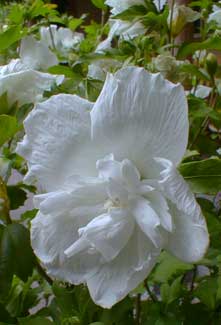
'Notwoodtwo' aka 'White Chiffon'
Semi-Double Rose of Sharon
"I will gather Roses of Sharon, my Soul,
The Roses of Sharon so cool & so sweet;
And our brothers shall see me entwining the whole
For a garland to drop at my dear Annie's feet."
-Henry Kendall
(1839-1882)
(1839-1882)
Introduced in 1997, Hibiscus syriacus 'White Chiffon' (registered as 'Notwoodtwo') is a semi-double Rose of Sharon, Hardy Hibiscus, or Althea. Peak flowering is June through August, or until first frost, a choice bush to place amidst spring-blooming shrubs so that there is something abloom late in the year.
Discovered by Dr. Roderick Woods, an amateur flower breeder of Cambridge, England, the variety came close to not being saved. Dr. Woods was attempting to breed an improved pink when there appeared among his plants anemone-flowered sports. Each blossom begins with a large single, at the center of which is a lacy cluster of petaloid stamens.
Because they were not the pink Dr. Woods was after, these sports were nearly destroyed, but Ivan Dickings, former curator of England's National Hibiscus Collection in Woodbridge, Suffolk, saved out two specimens that had the best potential for further development. These became 'White Chiffon' & 'Lavender Chiffon' initially marketed through Nottcutts Nurseries in Suffolk.
It can be slow growing at first, so well worth investing in a larger specimen to start with. Once it has a large root system, it will grow back swift & large every year from a hard prune.
It is solidly mature at four feet but can over time become a large woody shrub at eight feet high & six wide, though responsive to pruning to keep it smaller. It is far less likely than most rose of sharons to get rangy, being naturally more compactly stemmed & leafed.
Suitable for zones 5 through 8, it requires full sun. Though drought hardy when established, it should not be too greatly stressed for lack of irrigation at high summer, or it may drop its buds.
Many shrubs when stressed, but hibiscuses in particular, drop buds when conditions drift away from optimal. They will produce a big dose of the chemical hormone ethylene which loosens the buds from the branches. It's a self-preservation technique so a shrub can concentrate on staying alive through hard times, rather than expending energy on flowering & fruiting.
This can happen from transplant shock, or from insufficient watering, or from over-watering, over-fertilizing, exposure to pollution or harsh gardening chemicals slathered about by non-organic gardening methods, lack of beneficial fungal microorganisms in the soil, or fighting off a harmful root fungus or grubs.
If one experiences this bud-drop the fix would require first identifying the cause. The shrub is not necessarily at any risk beyond flowering poorly until the stressing condition is rectified. With a newly obtained shrub, often there is no fault with the gardener's method. Non-organic growers use an ethylene-suppressant & other nasty chemicals to keep shrubs smart-looking for the longest possible length of time for potted sales of shrubs in full bloom.
It's one of the many wicked tricks done to plants, hence to customers, who'll see the specimen seemingly decline rapidly & blame their own lack of a green thumb, when in reality the shrub had just been in a state of artificial preservation long enough to get the sale before its weeks of stress getting to market show effect. Such a specimen should bounce back fine the following year.